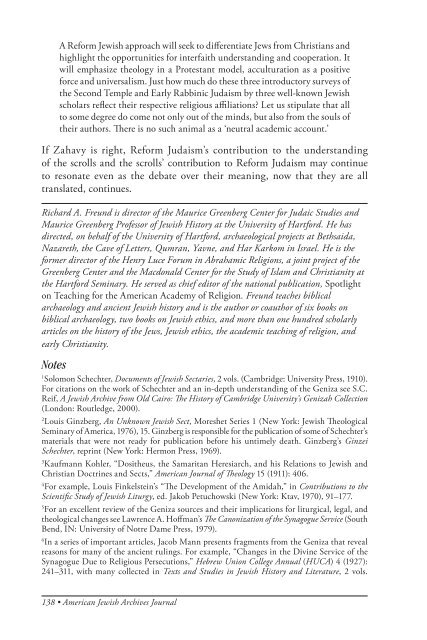The American Jewish Archives Journal, Volume LXI 2009, Number 1
The American Jewish Archives Journal, Volume LXI 2009, Number 1
The American Jewish Archives Journal, Volume LXI 2009, Number 1
Create successful ePaper yourself
Turn your PDF publications into a flip-book with our unique Google optimized e-Paper software.
A Reform <strong>Jewish</strong> approach will seek to differentiate Jews from Christians and<br />
highlight the opportunities for interfaith understanding and cooperation. It<br />
will emphasize theology in a Protestant model, acculturation as a positive<br />
force and universalism. Just how much do these three introductory surveys of<br />
the Second Temple and Early Rabbinic Judaism by three well-known <strong>Jewish</strong><br />
scholars reflect their respective religious affiliations? Let us stipulate that all<br />
to some degree do come not only out of the minds, but also from the souls of<br />
their authors. <strong>The</strong>re is no such animal as a ‘neutral academic account.’<br />
If Zahavy is right, Reform Judaism’s contribution to the understanding<br />
of the scrolls and the scrolls’ contribution to Reform Judaism may continue<br />
to resonate even as the debate over their meaning, now that they are all<br />
translated, continues.<br />
Richard A. Freund is director of the Maurice Greenberg Center for Judaic Studies and<br />
Maurice Greenberg Professor of <strong>Jewish</strong> History at the University of Hartford. He has<br />
directed, on behalf of the University of Hartford, archaeological projects at Bethsaida,<br />
Nazareth, the Cave of Letters, Qumran, Yavne, and Har Karkom in Israel. He is the<br />
former director of the Henry Luce Forum in Abrahamic Religions, a joint project of the<br />
Greenberg Center and the Macdonald Center for the Study of Islam and Christianity at<br />
the Hartford Seminary. He served as chief editor of the national publication, Spotlight<br />
on Teaching for the <strong>American</strong> Academy of Religion. Freund teaches biblical<br />
archaeology and ancient <strong>Jewish</strong> history and is the author or coauthor of six books on<br />
biblical archaeology, two books on <strong>Jewish</strong> ethics, and more than one hundred scholarly<br />
articles on the history of the Jews, <strong>Jewish</strong> ethics, the academic teaching of religion, and<br />
early Christianity.<br />
Notes<br />
1 Solomon Schechter, Documents of <strong>Jewish</strong> Sectaries, 2 vols. (Cambridge: University Press, 1910).<br />
For citations on the work of Schechter and an in-depth understanding of the Geniza see S.C.<br />
Reif, A <strong>Jewish</strong> Archive from Old Cairo: <strong>The</strong> History of Cambridge University’s Genizah Collection<br />
(London: Routledge, 2000).<br />
2 Louis Ginzberg, An Unknown <strong>Jewish</strong> Sect, Moreshet Series 1 (New York: <strong>Jewish</strong> <strong>The</strong>ological<br />
Seminary of America, 1976), 15. Ginzberg is responsible for the publication of some of Schechter’s<br />
materials that were not ready for publication before his untimely death. Ginzberg’s Ginzei<br />
Schechter, reprint (New York: Hermon Press, 1969).<br />
3 Kaufmann Kohler, “Dositheus, the Samaritan Heresiarch, and his Relations to <strong>Jewish</strong> and<br />
Christian Doctrines and Sects,” <strong>American</strong> <strong>Journal</strong> of <strong>The</strong>ology 15 (1911): 406.<br />
4 For example, Louis Finkelstein’s “<strong>The</strong> Development of the Amidah,” in Contributions to the<br />
Scientific Study of <strong>Jewish</strong> Liturgy, ed. Jakob Petuchowski (New York: Ktav, 1970), 91–177.<br />
5 For an excellent review of the Geniza sources and their implications for liturgical, legal, and<br />
theological changes see Lawrence A. Hoffman’s <strong>The</strong> Canonization of the Synagogue Service (South<br />
Bend, IN: University of Notre Dame Press, 1979).<br />
6 In a series of important articles, Jacob Mann presents fragments from the Geniza that reveal<br />
reasons for many of the ancient rulings. For example, “Changes in the Divine Service of the<br />
Synagogue Due to Religious Persecutions,” Hebrew Union College Annual (HUCA) 4 (1927):<br />
241–311, with many collected in Texts and Studies in <strong>Jewish</strong> History and Literature, 2 vols.<br />
138 • <strong>American</strong> <strong>Jewish</strong> <strong>Archives</strong> <strong>Journal</strong>

















